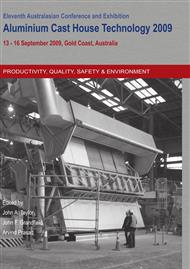p.103
p.111
p.119
p.129
p.137
p.147
p.155
p.165
p.175
Development of a Phosphate - Free Reticulated Foam Filter Material for Aluminium Cast Houses
Abstract:
Filtration of molten aluminium using porous reticulated ceramic foam was developed in 1974 by SELEE Corporation. Since that time, there have been significant technical advances in filter bowl design and construction, preheat systems, development of fine pore size filters, development of compact two-stage filtration systems, filter gasket materials, and equipment automation. One area that has remained relatively unchanged has been the refractory filter material technology. The refractory material utilized by all of the major cast house filter suppliers is based on an alumina aggregate grain bonded with aluminium phosphate (AlPO4). This filter material, commonly referred to as “PBA” in the aluminium industry, has become an industry wide standard and accounts for nearly 99% of the filters supplied to cast houses worldwide. There are significant technical limitations of PBA filters in terms of refractory performance, as well as potential environmental, health and safety concerns. This paper describes the development of a cost effective replacement filter material that overcomes the limitations of PBA filters. The new material utilizes a low expansion – low modulus aggregate material and a non-phosphate bond. The result is a significant reduction in mechanical failures during use, improved filtration performance and elimination of the issue of potential environmental, health and safety concerns.
Info:
Periodical:
Pages:
137-146
Citation:
Online since:
October 2009
Authors:
Keywords:
Price:
Сopyright:
© 2010 Trans Tech Publications Ltd. All Rights Reserved
Share:
Citation:


